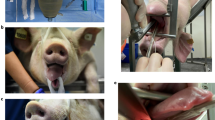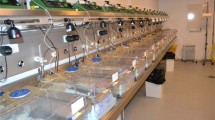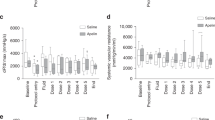Abstract
The piglet is an important animal model in biomedical research; many aspects of its anatomy, physiology and metabolism are similar to those of the human neonate. The authors describe a neonatal intensive care unit (NICU) for piglets. This unit allows researchers to model neonatal care in the NICU and can be used for a range of research studies. The authors hope that the model they describe can serve as a template for other investigators who would like to design their own piglet NICUs.
This is a preview of subscription content, access via your institution
Access options
Subscribe to this journal
We are sorry, but there is no personal subscription option available for your country.
Buy this article
- Purchase on Springer Link
- Instant access to full article PDF
Prices may be subject to local taxes which are calculated during checkout





Similar content being viewed by others
References
Van Goudoever, J.B. et al. Intestinal amino acid metabolism in neonates. Nestle Nutr. Workshop Ser. Pediatr. Program 58, 95–108 (2006).
Baltzell, J.K., Bazer, F.W., Miguel, S.G. & Borum, P.R. The neonatal piglet as a model for human neonatal carnitine metabolism. J. Nutr. 117, 754–757 (1987).
Butler, J.E. et al. The piglet as a model for B cell and immune system development. Vet. Immunol. Immunopathol. 128, 147–170 (2009).
Borum, P.R. Use of the colostrum-deprived piglet to evaluate parenteral feeding formulas. J. Nutr. 123, 391–394 (1993).
Institute of Laboratory Animal Resources. Guide for the Care and Use of Laboratory Animals 7th edn. (National Academy Press, Washington, DC, 1996).
Bollen, P.J.A., Hansen, A.K. & Olsen Alstrup, A.K. The Laboratory Swine 2nd edn. 18 (CRC, Boca Raton, FL, 2010).
Swiatek, K.R., Kipnis, D.M., Mason, G., Chao, K.L. & Cornblath, M. Starvation hypoglycemia in newborn pigs. Am. J. Physiol. 214, 400–405 (1968).
Textbook of Small Animal Surgery vol. 2, 2nd edn. (ed. Slatter, D.H.) (W.B. Saunders, Philadelphia, 1993).
Burrin, D.G., Shulman, R.J., Reeds, P.J., Davis, T.A. & Gravitt, K.R. Porcine colostrums and milk stimulate visceral organ and skeletal muscle protein synthesis in neonatal piglets. J. Nutr. 122, 1205–1213 (1992).
Elango, R., Goonewardene, L.A., Pencharz, P.B. & Ball, R.O. Parenteral and enteral routes of feeding in neonatal piglets require different ratios of branched-chain amino acids. J. Nutr. 134, 72–78 (2004).
Sangild, P.T. et al. Preterm birth affects the intestinal response to parenteral and enteral nutrition in newborn pigs. J. Nutr. 132, 3786–3794 (2002).
Acknowledgements
We thank Kristin Smith, Adam Katzman, Gary Borum, David McDonald, Marshall Haynick and the countless other InvestiGators who have contributed to the piglet experiments.
Author information
Authors and Affiliations
Corresponding author
Ethics declarations
Competing interests
The authors declare no competing financial interests.
Rights and permissions
About this article
Cite this article
Lennon, D., Zanganeh, T. & Borum, P. Development of the piglet neonatal intensive care unit for translational research. Lab Anim 40, 253–258 (2011). https://doi.org/10.1038/laban0811-253
Received:
Accepted:
Published:
Issue Date:
DOI: https://doi.org/10.1038/laban0811-253



